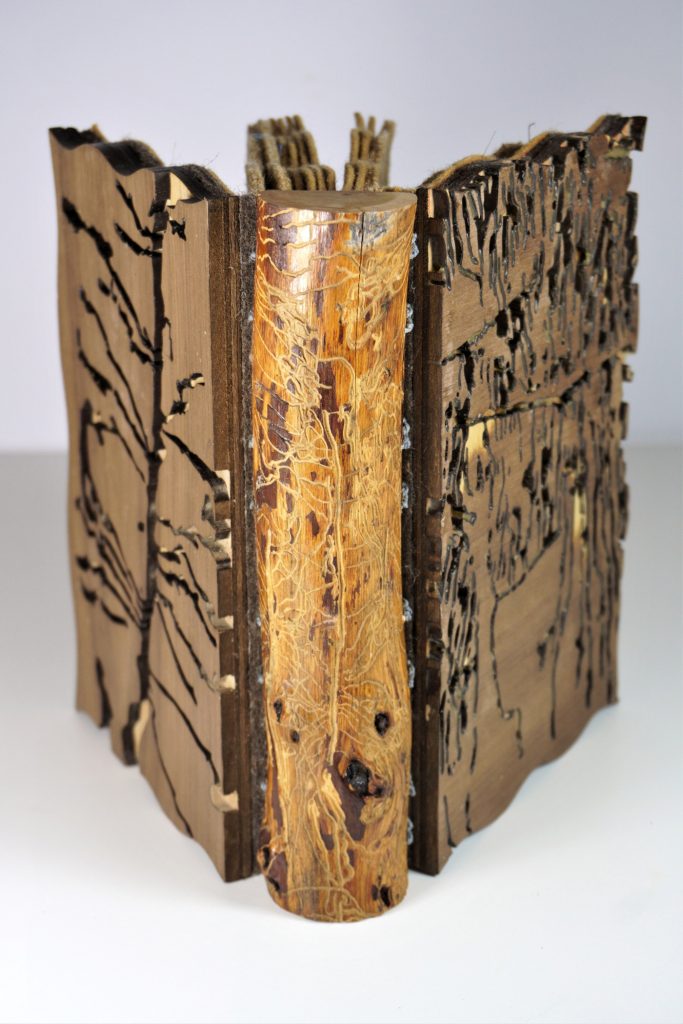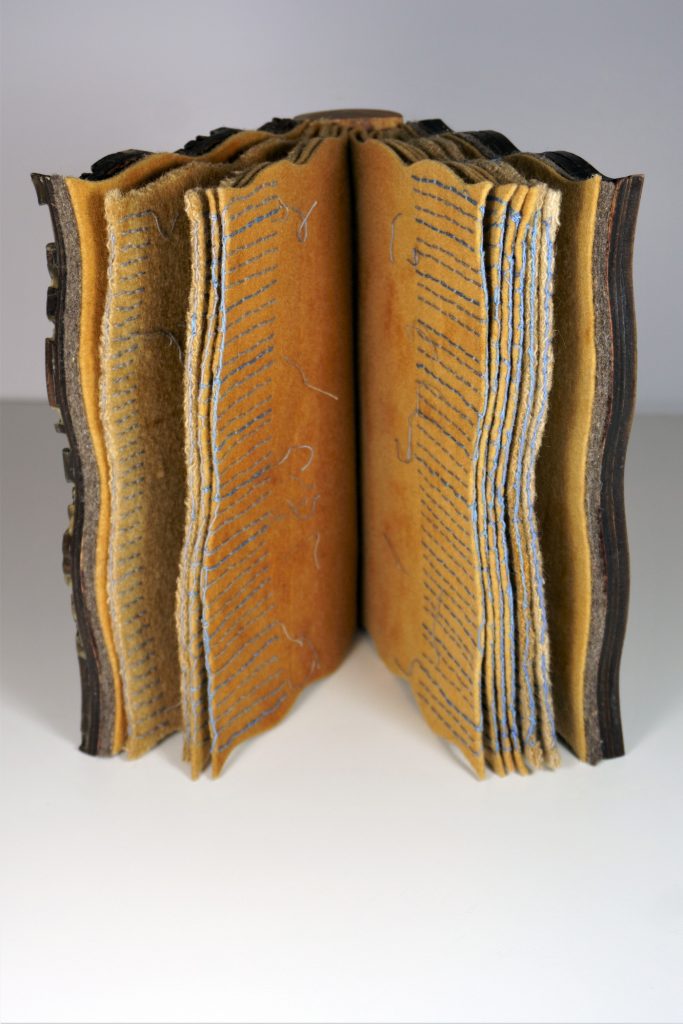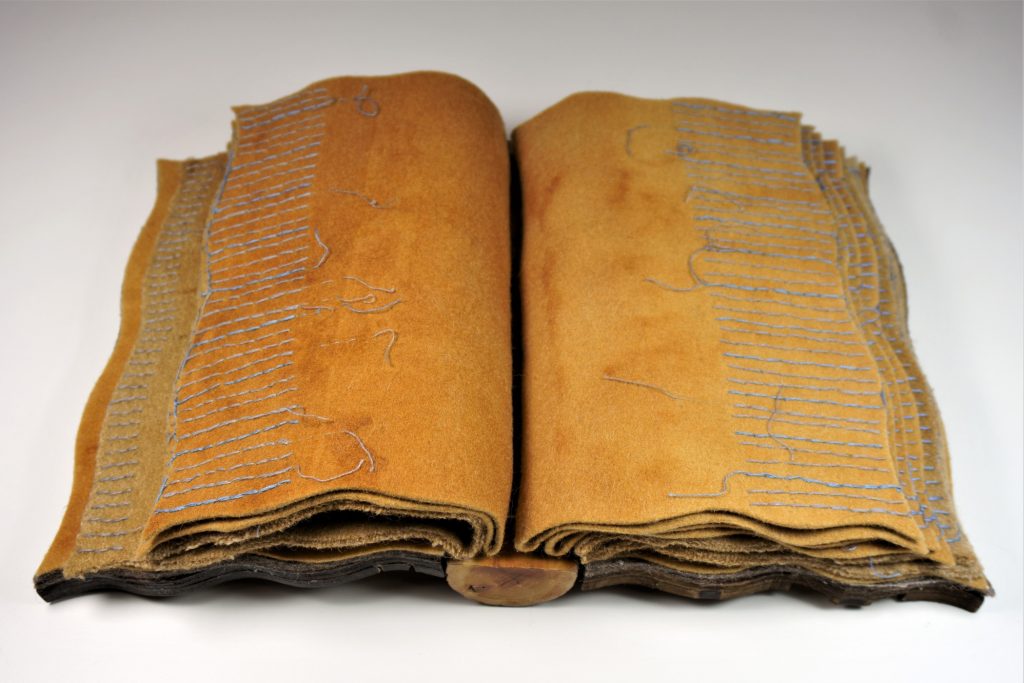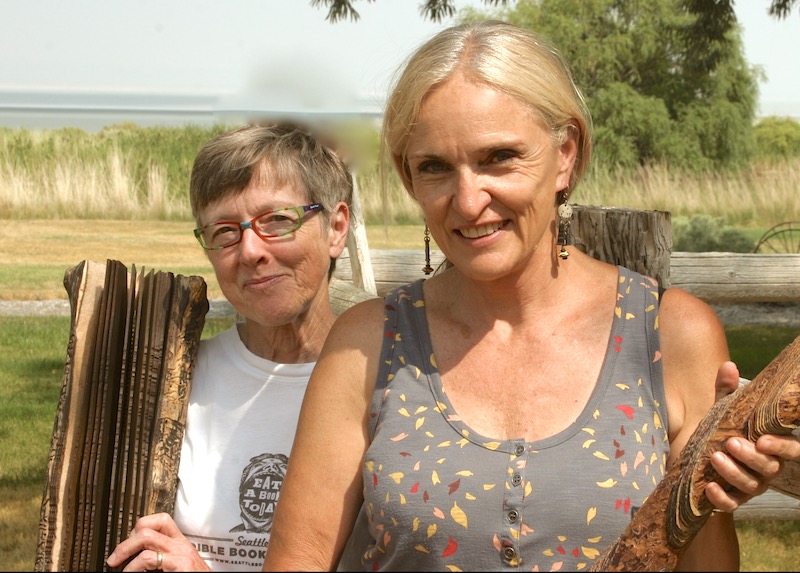Suze Woolf (artist) and Diana Six (scientist)

The front and back covers simulate the patterns of two common bark beetle specie that attack trees en masse: fir engraver on the front and Douglas fir beetle on the back. The spine is an actual branch, as found, from a forest with many trees dead from bark beetle depredations.

Certain bark beetles carry with them a fungus which helps them digest wood, leaving a characteristic blue-grey stain in the sapwood. The fungi’s microfilaments snake into wood, evoked by the embroidery on the pages, which changes from grey to blue.

Because each partner in the relationship obtains a vital benefit – the beetles receive nutrients they couldn’t survive without, the fungi are transported by the beetles to the next tree – it is called an obligate mutualism.
Photos by Suze Woolf
About Bark Beetle Book Vol. XXXII: Obligate Mutualism, artist Suze Woolf writes, I am preoccupied with climate impacts on Northwest forests. Hiking through forests burned and yet to burn, I observe the hieroglyphic “scribing” of bark beetles on inner bark and wood. The winding marks seem like a script I cannot read as if their trails (called “galleries”) are cryptograms we fail to decipher. A book, loosely defined, is a collection of messages, and incorporating raw materials from nature becomes a meditation on those materials’ disturbing beauty, as well as an opportunity to learn from foresters and entomologists.
Beetle-kill is compounded by climate change: trees stressed by heat and drought are more vulnerable, and the beetles’ larvae no longer freeze during warmer winters. Reproduction rates soar, tipping their populations from endemic to an epidemic. Only a few species attack live trees. Even those “aggressive” beetles are a normal disturbance agent like fire – but they are enthusiastically responding to the conditions we created: a warming world, a century of fire suppression, and a vast menu of even-aged agri-timber resources over which we and the beetles now compete.
Size: 8.75″H x 6.75″W x 3″D
Materials: The materials in this book include a branch from Washington’s Teanaway valley for the spine, laser-cut wood panels for the covers, iron-oxide-dyed felt embroidered with blue and grey linen thread, and industrial felt acting as endpapers.
Book Structure: Western codex in the felt pages with the novel half-branch spine, drilled so sewing threads pass through the spine. Covers were laser-cut to imitate the galleries of two specific beetle species, Douglas fir beetle and Fir engraver.
Printing/Production Method: Sewing (for the felt signatures) and embroidery (for the page graphics), plus gluing the signatures into the covers with felt “endpapers.”
Edition: Unique
Year Created: 2020

Suze Woolf, (on the left) a Seattle-based artist, studied ceramics and printmaking at the University of Washington and worked in computer graphics for many years. Inspired by nature and science, she explores media from painting, paper-casting, artist books, and pyrography to installation – sometimes all together. She has completed numerous artist residencies, curated exhibitions, and her work has been shown in galleries and museums throughout the western United States.
Suze Woolf: e-mail: woolf_s@msn.com; website: http://www.suzewoolf-fineart.com; Blog: https://suzeart.wordpress.com/
Diana Six (on the right) is an ecologist and entomologist who conducts research on the interactions between microbes, insects, and forests. Her main study system is that of bark beetles and their mutualistic fungi and how the partnership between the two has evolved into one of the most powerful forces influencing conifer forests. Her work now extends to how climate change is driving bigger bark beetle outbreaks and how mega-outbreaks are affecting the genetic diversity of the forest trees that survive. Her research sites can be found in western North America, Germany, and South Africa. She is an intense lover of nature and pursuer of fish by way of a fly rod.
Professor Diana Six: e-mail: diana.six@umontana.edu
About her research at the University of Montana, Professor Six writes: “My research looks at the ecology and evolution of interactions between insects and microbes and how those interactions affect the forest ecosystem. In particular, I study fungi that are carried from tree to tree by bark beetles. These fungi are crucial for beetle survival. They gather and deliver nutrients to the larvae as they feed and provide sterols that allow them to make hormones needed for reproduction. Having fungi as partners has allowed these insects to be the top killers of conifers world-wide. Prior to climate change, beetle outbreaks were natural disturbances beneficial to the forest. They initiated new growth and created a diverse forest structure supporting greater biodiversity. However, climate change is now driving mega- outbreaks that can reduce biodiversity and create major shifts in forest structure. Part of my research is looking at the genetic diversity that remains in a forest after a large climate-driven outbreak. My research shows that forests have considerable genetic potential to adapt to climate change but that current management practices may reduce that potential. I am working to develop approaches where genetic diversity and structuring in forest trees is included in forest adaptation and conservation efforts.”
